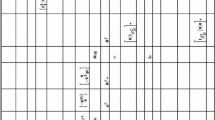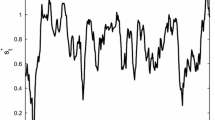Abstract
Economies with lack of commitment have been extensively studied using instruments like collateral and market exclusion. In collateral models agents cannot transfer wealth from the future and an efficient allocation may not be implementable even if markets are complete. We study an economy with secured and unsecured assets, the last ones are important in allowing transfers from the future. Bankruptcy punishment is the seizure of a fraction of agent’s income, this results in a non-convex budget set. We provide some conditions to implement the Arrow Debreu allocation (AD) with a large enough seizure rate, indirectly proving equilibrium existence. Further, we perform a numerical exercise with US data to prove that if agents in the lower income quartile have a positive probability of coming up to a larger one (more social mobility) then we can implement AD and the minimum seizure rate depends inversely on this probability.
Similar content being viewed by others
References
Araujo, A.P.: General equilibrium, preferences and financial institutions after the crisis. Econ. Theor. 58(2), 217–254 (2015)
Araujo, A.P., Páscoa, M.R.: Bancruptcy in a model of unsecured claims. Econ. Theor. 20(3), 455–481 (2002)
Araujo, A.P., Ferreira, R.V., Funchal, B.: The Brazilian bankruptcy law experience. J. Corp. Finance 18(4), 994–1004 (2012a). special Section: Contemporary corporate finance research on South America
Araujo, A.P., Kubler, F., Schommer, S.: Regulating collateral-requirements when markets are incomplete. J. Econ. Theory 147(2), 450–476 (2012b)
Azariadis, C., Kaas, L.: Endogenous credit limits with small default costs. J. Econ. Theory 148(2), 806–824 (2013)
Azariadis, C., Kaas, L., Wen, Y.: Self-fulfilling credit cycles. Rev. Econ. Stud. 83(4), 1364–1405 (2016)
Berge, C.: Topological Spaces. Oliver and Boyd LTD, Edinburgh (1963)
Bureau, UC.: Survey of income and program participation. Tech. rep., U.S. Census Bureau (1996-2008)
Chatterjee, S., Corbae, D., Nakajima, M., Ríos-Rull, J.V.: A quantitative theory of unsecured consumer credit with risk of default. Econometrica 75(6), 1525–1589 (2007)
Di , Z.: Growing wealth, inequality, and housing in the united states. Tech. rep., Harvard University’s Joint Center for Housing Studies (2007)
Fostel, A., Geanakoplos, J.: Endogenous collateral constraints and the leverage cycle. Annu. Rev. Econ. 6(1), 771–799 (2014)
Geanakoplos, J.: Collaterized asset markets (2007)
Geanakoplos, J., Zame, W.R.: Collateral equilibrium, i: a basic framework. Econ. Theory 56(3), 443–492 (2014)
Hart, O.: On the optimality of equilibrium when the market structure is incomplete. J. Econ. Theory 11(3), 418–443 (1975)
Hart, O.: Different Approaches to Bankruptcy, proceedings of the annual bank conference on development economics in Europe, June 21–21, 1999. edn, Paris: La Docmentation Francaise, 2000. Proceedings of the Annual Bank Conference on Development Economics in Europe, June 21-23, 1999 (Paris: La Documentation Francaise, 2000) (1999)
Hart, O., Djankov, S., McLiesh, C., Shleifer, A.: Debt enforcement around the world. J. Polit. Econ. 116(6), 1105–1149 (2008)
Hertz, T.: Understanding mobility in America. Tech. rep, Center for Amenrican Progress (2006)
Hintermaier, T., Koeniger, W.: Debt portfolios and homestead exemptions. Am. Econ. J. Macroecon. 8(4), 103–41 (2016)
Kehoe, T.J., Levine, D.K.: Debt-constrained asset markets. Rev. Econ. Stud. 1993, 865–888 (1993)
Leippold, M., Vanini, P., Ebnoether, S.: Optimal credit limit management under different information regimes. J. Bank. Finance 30(2), 463–487 (2006)
Magill, M., Quinzii, M.: Theory of Incomplete Markets, vol. 1. MIT Press, Cambridge (2002)
Mas-Colell, A., Whinston, M.D., Green, J.R.: Microeconomic Theory. Oxford University Press, Oxford (1995)
Mateos-Planas, X.: Credit limits and bankruptcy. Econ. Lett. 121(3), 469–472 (2013)
Poblete-Cazenave, R., Torres-Martínez, J.P.: Equilibrium with limited-recourse collateralized loans. Econ. Theory 53(1), 181–211 (2013)
Ponticelli, J., Alencar, L.S.: Court enforcement, bank loans, and firm investment: evidence from a bankruptcy reform in Brazil*. Q. J. Econ. 131(3), 1365–1413 (2016)
Sabarwal, T.: Competitive equilibria with incomplete markets and endogenous bankruptcy. Contributions to Theoretical Economics (2003)
Yao, R., Zhang, H.H.: Optimal consumption and portfolio choices with risky housing and borrowing constraints. Rev. Financ. Stud. 18(1), 197–239 (2005)
Zame, W.R.: Efficiency and the role of default when security markets are incomplete. Am. Econ. Rev. 83(5), 1142–1164 (1993)
Author information
Authors and Affiliations
Corresponding author
Additional information
Publisher's Note
Springer Nature remains neutral with regard to jurisdictional claims in published maps and institutional affiliations.
Rights and permissions
About this article
Cite this article
Araujo, A., Villalba, J.M. Equilibrium efficiency with secured and unsecured assets. Econ Theory 73, 1025–1049 (2022). https://doi.org/10.1007/s00199-021-01343-y
Received:
Accepted:
Published:
Issue Date:
DOI: https://doi.org/10.1007/s00199-021-01343-y




